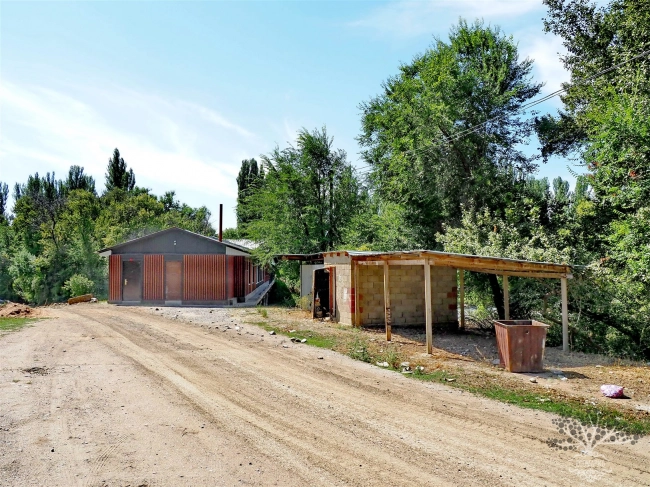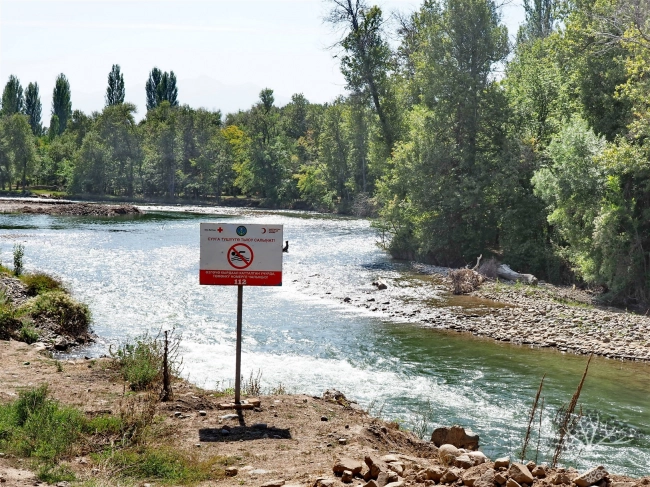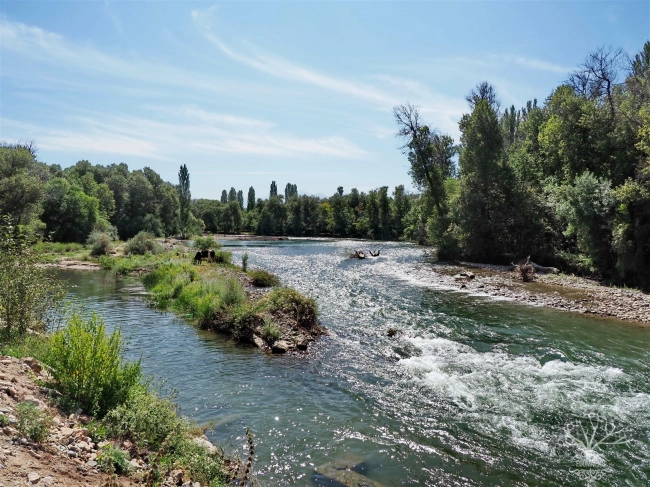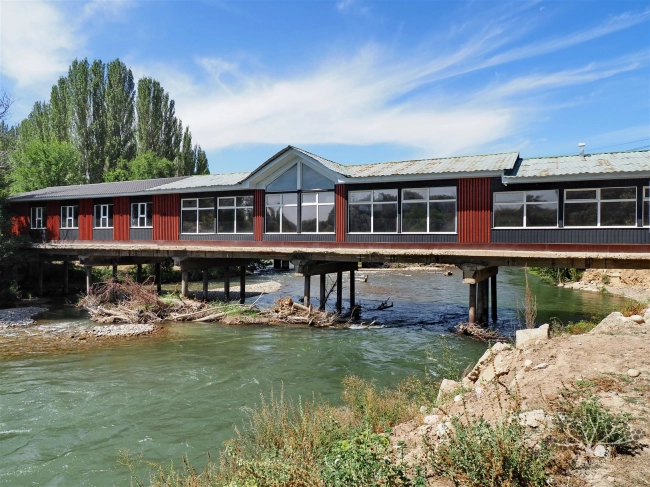Placement of Septics in the Floodplain Zone of the Talas River
Coordinates: 42.540987, 72.206627
Septic tanks in floodplain areas of rivers pose a serious ecological and sanitary threat. Floodplain areas are low-lying regions that are periodically flooded by rivers during high water or heavy rains. These areas play an important role in ecosystems, supporting biodiversity, filtering water, and creating habitats for numerous species of plants and animals. The use of septic tanks in such zones is dangerous for both the environment and human health for a number of reasons.
Contamination of Groundwater and Surface Water
Direct contact with water: Floodplain areas are often prone to flooding, which means that runoff from septic tanks can directly enter rivers and streams. As a result, untreated or inadequately treated wastewater contains numerous pollutants, such as bacteria, viruses, chemical compounds, and nutrients (nitrates and phosphates), which negatively affect water quality.
Contamination of groundwater: Water in floodplain areas is close to the surface, and soils often have high permeability. This facilitates the infiltration of wastewater from septic tanks into groundwater. Groundwater contamination can lead to a deterioration in drinking water quality, especially if wells or water intake sources are nearby.
Development of Pathogenic Microorganisms
Bacteriological contamination: Septic tanks are sources of fecal bacteria, such as E. coli, and other pathogenic microorganisms, including viruses and parasites. When these organisms enter water resources, they can cause serious infectious diseases in humans and animals, such as intestinal infections, hepatitis, and others. Water in floodplain areas, especially during warm weather, can become a source of widespread disease outbreaks.
Spread of diseases through food chains: Contaminated water can reach agricultural lands irrigated by rivers or be used for watering crops. Pathogens that contaminate agricultural produce can enter food products, posing a health threat to humans upon consumption.
Eutrophication of Water Bodies
Excess nutrients: Wastewater from septic tanks contains high levels of nitrogen and phosphorus, which promote accelerated growth of algae and other aquatic plants. This process is called eutrophication. Excessive algae growth leads to "blooms" in water bodies, resulting in decreased oxygen levels in the water, fish kills, and the death of other aquatic organisms.
Ecological consequences: Eutrophication disrupts the natural balance of water bodies, reducing biodiversity and degrading water quality. This can lead to the extinction of many species of fish and plants, which in turn negatively impacts the entire ecosystem, including waterfowl and other species dependent on aquatic ecosystems.
Risk of Drinking Water Contamination
Wells and water intakes: In rural areas, floodplain zones of rivers are often used for water intake and drinking water supply. Water contamination due to leaks from septic tanks can become a serious problem for the population, as many water treatment systems are not capable of effectively removing biological pollutants, nitrates, and other chemical compounds.
Human health: Contaminated drinking water can cause outbreaks of diseases, especially in children, the elderly, and people with weakened immune systems. Continuous consumption of water contaminated with wastewater can lead to chronic health issues, such as gastrointestinal diseases and even cancers caused by nitrates.
Destruction of Floodplain Forest Ecosystems
Destruction of vegetation: Floodplain forests contain many plants that are sensitive to changes in water and soil composition. Wastewater from septic tanks, containing chemical compounds and excess nutrients, can cause the death of trees and shrubs, leading to ecosystem degradation.
Disruption of food chains: When plants and animals in the floodplain suffer from pollution, it disrupts food chains, which can cause mass extinctions of various species, from insects to large animals. This leads to a loss of biodiversity and a deterioration of ecosystem functions, such as water filtration and flood protection.
Characteristics of Floodplain Areas
Floodplain areas of rivers have high permeability and natural water mobility, making them particularly vulnerable to pollution. During floods or rising water levels, septic tanks located near the river can overflow, and wastewater can directly enter the river, increasing the burden on the ecosystem.
Septic tanks in floodplain areas of rivers pose a serious threat to ecosystems and human health. Contamination of groundwater and surface water, the spread of pathogenic microorganisms and chemicals, eutrophication of water bodies—these are just some of the problems that arise from improper wastewater disposal. It is important to take measures to transition to safer wastewater treatment and disposal systems to protect floodplain areas and their unique ecosystems from destruction.
Septic tanks in floodplain areas of rivers pose a serious ecological and sanitary threat. Floodplain areas are low-lying regions that are periodically flooded by rivers during high water or heavy rains. These areas play an important role in ecosystems, supporting biodiversity, filtering water, and creating habitats for numerous species of plants and animals. The use of septic tanks in such zones is dangerous for both the environment and human health for a number of reasons.
Contamination of Groundwater and Surface Water
Direct contact with water: Floodplain areas are often prone to flooding, which means that runoff from septic tanks can directly enter rivers and streams. As a result, untreated or inadequately treated wastewater contains numerous pollutants, such as bacteria, viruses, chemical compounds, and nutrients (nitrates and phosphates), which negatively affect water quality.
Contamination of groundwater: Water in floodplain areas is close to the surface, and soils often have high permeability. This facilitates the infiltration of wastewater from septic tanks into groundwater. Groundwater contamination can lead to a deterioration in drinking water quality, especially if wells or water intake sources are nearby.
Development of Pathogenic Microorganisms
Bacteriological contamination: Septic tanks are sources of fecal bacteria, such as E. coli, and other pathogenic microorganisms, including viruses and parasites. When these organisms enter water resources, they can cause serious infectious diseases in humans and animals, such as intestinal infections, hepatitis, and others. Water in floodplain areas, especially during warm weather, can become a source of widespread disease outbreaks.
Spread of diseases through food chains: Contaminated water can reach agricultural lands irrigated by rivers or be used for watering crops. Pathogens that contaminate agricultural produce can enter food products, posing a health threat to humans upon consumption.
Eutrophication of Water Bodies
Excess nutrients: Wastewater from septic tanks contains high levels of nitrogen and phosphorus, which promote accelerated growth of algae and other aquatic plants. This process is called eutrophication. Excessive algae growth leads to "blooms" in water bodies, resulting in decreased oxygen levels in the water, fish kills, and the death of other aquatic organisms.
Ecological consequences: Eutrophication disrupts the natural balance of water bodies, reducing biodiversity and degrading water quality. This can lead to the extinction of many species of fish and plants, which in turn negatively impacts the entire ecosystem, including waterfowl and other species dependent on aquatic ecosystems.
Risk of Drinking Water Contamination
Wells and water intakes: In rural areas, floodplain zones of rivers are often used for water intake and drinking water supply. Water contamination due to leaks from septic tanks can become a serious problem for the population, as many water treatment systems are not capable of effectively removing biological pollutants, nitrates, and other chemical compounds.
Human health: Contaminated drinking water can cause outbreaks of diseases, especially in children, the elderly, and people with weakened immune systems. Continuous consumption of water contaminated with wastewater can lead to chronic health issues, such as gastrointestinal diseases and even cancers caused by nitrates.
Destruction of Floodplain Forest Ecosystems
Destruction of vegetation: Floodplain forests contain many plants that are sensitive to changes in water and soil composition. Wastewater from septic tanks, containing chemical compounds and excess nutrients, can cause the death of trees and shrubs, leading to ecosystem degradation.
Disruption of food chains: When plants and animals in the floodplain suffer from pollution, it disrupts food chains, which can cause mass extinctions of various species, from insects to large animals. This leads to a loss of biodiversity and a deterioration of ecosystem functions, such as water filtration and flood protection.
Characteristics of Floodplain Areas
Floodplain areas of rivers have high permeability and natural water mobility, making them particularly vulnerable to pollution. During floods or rising water levels, septic tanks located near the river can overflow, and wastewater can directly enter the river, increasing the burden on the ecosystem.
Septic tanks in floodplain areas of rivers pose a serious threat to ecosystems and human health. Contamination of groundwater and surface water, the spread of pathogenic microorganisms and chemicals, eutrophication of water bodies—these are just some of the problems that arise from improper wastewater disposal. It is important to take measures to transition to safer wastewater treatment and disposal systems to protect floodplain areas and their unique ecosystems from destruction.
This research was conducted with the support of the Global Greengrants Fund (GGF), one of the leading donor organizations in the world that supports the efforts of ordinary people to protect the planet Earth. #GlobalGreengrantsFund #GreengrantsFund #Greengrants #GGF #GlobalGreengrantsFund


























Attention: Information based on submitted complaints